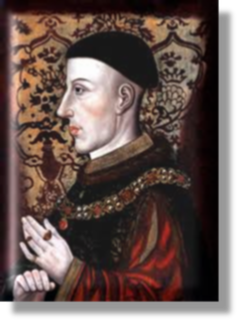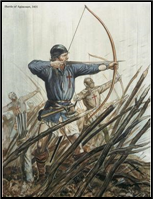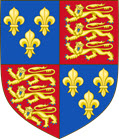 xxxxxLong before Henry V came to the throne he had gained a
reputation as a good military tactician and an outstanding leader of
men. He had fought against the Welsh rebels, campaigned against the
Percys of Northumberland, and had already led an expedition to
France. It was inevitable that this experienced soldier, on coming
to the throne, would seek to revive England’s fortunes and prestige
on the continent. The renewal of the Hundred Years’ War was about to
take place.
xxxxxLong before Henry V came to the throne he had gained a
reputation as a good military tactician and an outstanding leader of
men. He had fought against the Welsh rebels, campaigned against the
Percys of Northumberland, and had already led an expedition to
France. It was inevitable that this experienced soldier, on coming
to the throne, would seek to revive England’s fortunes and prestige
on the continent. The renewal of the Hundred Years’ War was about to
take place.
xxxxxAs a man, Henry was
intolerant and domineering, but he was every inch a king, brave,
loyal and decisive. He was undoubtedly a popular monarch. Having a
reasonable claim to the French throne, aware that France was split
by civil war, and knowing that the promise of continental gains
tended to ensure the loyalty of his noblemen, he embarked almost at
once upon a campaign of conquest. By his famous triumph at the
Battle of Agincourt and a string of minor victories a few years
later, he overran Normandy and captured Rouen after a long siege.
Such was the measure of his success that in 1420 the Treaty of
Troyes recognised him as heir to the French throne and, later that
year, he married Katherine, the daughter of the French King. But the
Dauphin, the rightful heir to the French throne, was not a party to
the treaty and so the fighting continued. Then two years later, soon
after raising the siege of Meaux in the Loire Valley, Henry was
taken ill and died. With him died the hopes of an English king on a
French throne.
 xxxxxIt is certainly true that, because of his success on the
battlefield, his reign did much to restore good relations between
the monarch and his nobles. Indeed, as early as his coronation, he
had gone out of his way to make peace with many of those barons who
had suffered at the hands of his father. Furthermore, as an act of
reconciliation, he had had the body of Richard II removed from its
humble grave and reburied in Westminster Abbey. Unfortunately such
unusual harmony was not to last beyond his death. Furthermore,
conquest abroad did not automatically make the reign a success. On
the continent, he made England the most powerful nation in Europe,
but in fact his reign was little short of a disaster. The campaigns
in France, apart from the enormous burden of taxation they caused,
created an empire which, in reality, was going to be too difficult
to maintain, let alone retain. A few years after Henry’s death most
of his possessions in France had been overrun.
xxxxxIt is certainly true that, because of his success on the
battlefield, his reign did much to restore good relations between
the monarch and his nobles. Indeed, as early as his coronation, he
had gone out of his way to make peace with many of those barons who
had suffered at the hands of his father. Furthermore, as an act of
reconciliation, he had had the body of Richard II removed from its
humble grave and reburied in Westminster Abbey. Unfortunately such
unusual harmony was not to last beyond his death. Furthermore,
conquest abroad did not automatically make the reign a success. On
the continent, he made England the most powerful nation in Europe,
but in fact his reign was little short of a disaster. The campaigns
in France, apart from the enormous burden of taxation they caused,
created an empire which, in reality, was going to be too difficult
to maintain, let alone retain. A few years after Henry’s death most
of his possessions in France had been overrun.
xxxxxAt home, too, Henry’s long
periods of absence meant a lack of leadership where it was most
needed. There was still much disquiet about the Lancastrian
succession, notably in the west and north of the country, and the
Lollards - making much capital out of the Great Schism -
were stirring up a great deal of unrest by their opposition to the
papacy. The execution of their leader Sir John Oldcastle in 1417 did
not crush the movement, but served only to drive it deeper
underground. Furthermore, just before he left for France in the
summer of 1415, he was faced with a serious conspiracy. He learnt of
a plot to replace him with Edmund Mortimer, Earl of March. He
swiftly searched out and executed the conspirators, but this event
was a measure of the unrest simmering just beneath the surface.
xxxxxHis remarkable success at
the Battle of Agincourt brought him personal fame and what today
would be termed “international status”. The German king himself,
Sigismund, visited Canterbury in 1416 to make an alliance, and
later, in the Council of Constance, it was the co-operation
between these two monarchs that paved the way for the acceptance of
a new pope and the end of the Great Schism.
xxxxxBut the long campaigns on
the continent put an enormous strain on the king, young though he
was. Henry had laid claim to vast areas of France at the start of
his first campaign, and despite his victory at Agincourt, his aim
was not to engage the French in pitched battles, but to conquer
enemy territory by a series of sieges. Once captured, the great
towns and fortresses of northern France were used to subdue and rule
over the surrounding countryside. It was a strategy that he carried
out for seven arduous years and which, by 1422, had left him
physically exhausted. Thus, at the height of his career and with the
throne of France within his grasp, he was suddenly weakened by
dysentery and died at the chateau of Vincennes in the Loire Valley.
He was just 36 years of age. England had lost a warrior king and
received in his place a babe of nine months, the youngest monarch
the country has ever had. It was not a promising prospect.









 xxxxx
xxxxx xxxxx
xxxxx claim
to the French throne, and renewing
claim
to the French throne, and renewing
